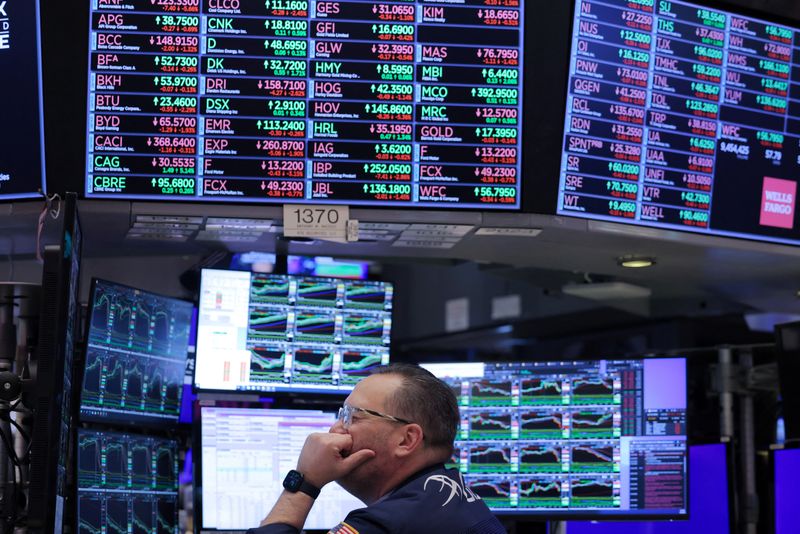Stock market today: Nasdaq closes above 23,000 for first time as tech rebounds
Investing.com - U.S. stock futures edged down on Thursday, with markets assessing developments in President Donald Trump’s trade policy and recent inflation figures. Producer prices are tipped to cool in February, although worries persist over the possible impact of Trump’s tariffs on inflation and wider economic activity. Traders will be keeping tabs on an expected meeting between Trump administration officials and the Premier of Canada’s Ontario province, as a spat over levies between the U.S. and its neighbor to the north deepens.
1. Futures lower
U.S. stock futures pointed lower, as investors gauged President Trump’s tariff plans and looked ahead to the release of fresh producer price data.
By 04:41 ET (08:41 GMT), the S&P 500 futures contract had slid by 32 points or 0.6%, Nasdaq 100 futures had fallen by 163 points or 0.8%, and Dow futures had slipped by 150 points or 0.4%.
The main indices were mixed at the close of trading on Wednesday, with the benchmark S&P 500 and tech-heavy Nasdaq 100 rising thanks in large part to surge in technology and tech-related stocks. The blue-chip Dow Jones Industrial Average ended lower following a choppy session.
A tame reading of U.S. inflation provided some lift to equities, although sentiment was tempered by ongoing worries over the potential impact of Trump’s trade agenda on overall economic activity.
"It’s little surprise that inflation data for February hardly moved the dial for the U.S. stock market –- that probably requires clarity on trade policy and signs of economic resilience," said James Reilly, Senior Markets Economist at Capital Economics.
2. PPI ahead
Markets are due to be keeping an eye on a monthly measure of producer price growth on Thursday, which could help flesh out the state of U.S. inflation.
Economists expect the Labor Department’s producer price index for final demand to cool to 3.3% in the twelve months to February from a prior level of 3.5%. Month-on-month, it is seen slowing to 0.3% from 0.4%.
The report is set to come after a separate metric on Wednesday showed that consumer prices increased at a slower-than-anticipated pace last month, possibly presenting an upbeat piece of news for Trump as he pushes ahead with his plans to overhaul the U.S. trading relationship with friends and adversaries alike. Hopes that the Federal Reserve will slash interest rates later this year were also buoyed.
However, analysts remained concerned that the strife around Trump’s tariffs could still drive up inflationary pressures in the coming months and, in turn, threaten broader growth.
"[I]nvestors know a trade tape bomb can arrive at any moment," analysts at Vital Knowledge said in a note to clients.
3. Lutnick-Ford talks expected
The next twist in the ongoing tariff saga could come on Thursday, when Commerce Secretary Howard Lutnick and U.S. trade representative Jamieson Greer are expected to meet with Doug Ford, the Premier of the Canadian province of Ontario.
Ford has said that the three will discuss a renewal to the United States-Mexico-Canada trade agreement, which was signed during Trump’s first term in office.
The gathering will come after the U.S. allowed expanded and sweeping 25% levies on steel and aluminum to come into effect on Wednesday.
In response, Canada, the largest supplier of steel and aluminum to the U.S., announced retaliatory tariffs on C$29.8 billion worth of U.S. goods. Ottawa has already slapped tariffs worth a similar amount on U.S. goods as an answer to broader duties rolled out by Trump.
Earlier this week, Ford became the target of Trump’s ire after Ford vowed to place a 25% surcharge on electricity exported from Ontario to the U.S. However, following discussions with Lutnick and a threat from Trump to double the Canadian steel and aluminum tariffs to 50%, Ford temporarily suspended the trade tax.
4. New Intel CEO
Shares in Intel (NASDAQ:INTC) rose in extended hours trading after the chipmaker announced the appointment of Lip-Bu Tan as its next Chief Executive.
He succeeds interim co-CEOs David Zinsner and Michelle Johnston Holthaus, with Zinsner staying on as CFO and Holthaus continuing as CEO of Intel Products.
The appointment, which will take effect March 18, comes three months after the departure of former CEO Pat Gelsinger, who had overseen a costly -- but ultimately faltering -- drive to turn around the business.
In a letter to employees, Tan said he sees the company working hard to "restore" its position as a "world-class products" firm and establish a strong foundry unit.
Analysts at Stifel said they view Tan’s appointment as a long-term positive but cautioned that Intel still faces a prolonged transition as it realigns with the rapidly-evolving artificial intelligence-driven semiconductor market.
5. Bitcoin muted
Bitcoin hovered around the flatline on Thursday, stablizing after recent losses, as sentiment was bolstered slightly by the softer-than-expected U.S. consumer price data.
But gains in Bitcoin and the broader crypto sector were limited as risk appetite remained under pressure from persistent concerns over an escalating trade war, as well as fears over a potential recession.
The world’s biggest cryptocurrency had slumped below $80,000 earlier this month on rampant risk-aversion, while Trump’s plans for a Bitcoin reserve also largely underwhelmed. However, dip-buying and some hopes of more friendly regulation helped Bitcoin mark a mild recovery.
Bitcoin rose 0.1% to $82,760.3 by 04:37 ET (08:37 GMT).
